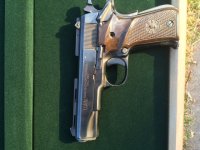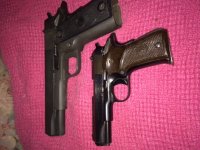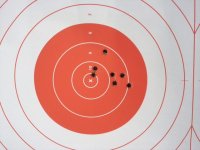These things take a beating on the Internet as junk. Not sure why. This one seems to be well made and I shot it for the first time today. 50 rounds of WWB FMJFP. Not a single hiccup. Up to 15 yards I could focus enough to get decent groups. Trigger pull isn't the best. But not bad. I bought it on a lark because I liked the way it looked. $250. Having issues posting more than one photo at a time. Will post additional in following posts.
You are using an out of date browser. It may not display this or other websites correctly.
You should upgrade or use an alternative browser.
You should upgrade or use an alternative browser.
Llama .380 (1911 Look Alike)
- Thread starter johnm1
- Start date
Darker Loaf
New member
That seems like a cool little gun! I've always wanted a smaller but still mostly full-sized .380. Neat-o.
I have a pile of the small Llamas mostly made before 1960 or the Micro Max just before end of production. The pistols are very well made and function as they should, then there was a time when the pistols look like they were machined with a butter knife (mostly the vent ribbed pistols) and had poor reliability. I have pistols in .22, .32, .380 and truely enjoy shooting them and would not feel under gunned carrying one of my sixty year old pistols. Good luck with your Llama, shoot it but don't dry fire without a snap cap.
Well, if you want a different name, Browning now makes one aabout this size. $500. Not sure if it is series 80, but it does have a magazine disconnect. I cant remember the finish though.
Brownings website formtheir 1911-.380 it is a better copy.
http://www.browning.com/products/interactive/firearms/1911-380/
Brownings website formtheir 1911-.380 it is a better copy.
http://www.browning.com/products/interactive/firearms/1911-380/
Last edited:
The Browning Has a polymer frame. Other than the magazine disconnect, the manufacturer indicates it is a clone of the original 1911 design as far as function goes. Actually I read that the magazine disconnect was included in the original patent for the 1911.
So I am assuming it is of the series's 70 design and not the series 80.
So I am assuming it is of the series's 70 design and not the series 80.
Patent 984519
The PDFs program I normally use won't pull this particular patent. The below is copied from the scanned version of the patent for the 1911. There are obvious scanning errors but at least from what I read, the magazine disconnect was a part of the original patent. Did JMB ever intend to use it on the 1911? I have no idea. He did successfully protect the idea though by including it in his patent for the 1911.
Copied with all of the scan errors:
"catch automatica 1v locks the trigger against operation when. the magazine is removed from the grip, and the-trigger is automat1'-' cally released for operation by the introduc- 9 ment of the barrel upon the frame."
"Another object -of the invention is to produce a firearm of this class in which, to insure absolutely against the dangerous accidental firing sometimes liable to occur if the hlgge" r is ulled after the ma azine hasbeen withdrawd in the belief thah all cartridges havebeen removed from the arm with the magazine, whereas the loaded cartridge last fed to the barrel still remains in the cham I her, the'magazine-catch shall not only lock the magazine in its seat or at will release the magazine, but the catch shall also automatically lock the trigger against operation whenever there 1s no magazine in the seat,"
There may be other surprises in the patent but the copy I have on screen is to difficult to read with all of the scan errors.
The PDFs program I normally use won't pull this particular patent. The below is copied from the scanned version of the patent for the 1911. There are obvious scanning errors but at least from what I read, the magazine disconnect was a part of the original patent. Did JMB ever intend to use it on the 1911? I have no idea. He did successfully protect the idea though by including it in his patent for the 1911.
Copied with all of the scan errors:
"catch automatica 1v locks the trigger against operation when. the magazine is removed from the grip, and the-trigger is automat1'-' cally released for operation by the introduc- 9 ment of the barrel upon the frame."
"Another object -of the invention is to produce a firearm of this class in which, to insure absolutely against the dangerous accidental firing sometimes liable to occur if the hlgge" r is ulled after the ma azine hasbeen withdrawd in the belief thah all cartridges havebeen removed from the arm with the magazine, whereas the loaded cartridge last fed to the barrel still remains in the cham I her, the'magazine-catch shall not only lock the magazine in its seat or at will release the magazine, but the catch shall also automatically lock the trigger against operation whenever there 1s no magazine in the seat,"
There may be other surprises in the patent but the copy I have on screen is to difficult to read with all of the scan errors.
Better copy without the scan errors. Patent number is 984519. Much easier to read.
“From the rear of the trigger t the rib t2 projects, extending to the upper forward side of the catch y and there registering with a corresponding recess y5 in the catch (see Figs. 7 and 7a,) so located therein laterally that it permits the trigger to be operated whenever a magazine is in the grip and the locking-rib y2 of the catch y has locked the magazine therein, as, with magazine and catch in these relative positions, the inner face of the locking-rib y2 rests against the forward edge of the recess x1 in the magazine, and this contact prevents the catch y from being moved by its spring fully to the left side to its released position. When, however, the magazine is unlocked and withdrawn from the grip, the catch y on its release is at once moved by its spring fully to the left side, its movement in that direction being then only limited by the contact with its seat in the grip of the shoulder on the catch formed where the reduced left end and the body meet; in this released position of the catch the recess in its upper forward side does not register with the rib t2 of the trigger and therefore the trigger is then locked in the forward position against rearward movement or operation. This automatic locking of the trigger in the absence of the magazine positively prevents accidental firing, due to the pulling of the trigger in the erroneous belief that all cartridges have been removed from the pistol by the removal of the magazine, whereas an unfired cartridge may have remained in the chamber of the barrel.
On introducing a magazine into the grip the trigger is automatically released, ready for operation. “
“From the rear of the trigger t the rib t2 projects, extending to the upper forward side of the catch y and there registering with a corresponding recess y5 in the catch (see Figs. 7 and 7a,) so located therein laterally that it permits the trigger to be operated whenever a magazine is in the grip and the locking-rib y2 of the catch y has locked the magazine therein, as, with magazine and catch in these relative positions, the inner face of the locking-rib y2 rests against the forward edge of the recess x1 in the magazine, and this contact prevents the catch y from being moved by its spring fully to the left side to its released position. When, however, the magazine is unlocked and withdrawn from the grip, the catch y on its release is at once moved by its spring fully to the left side, its movement in that direction being then only limited by the contact with its seat in the grip of the shoulder on the catch formed where the reduced left end and the body meet; in this released position of the catch the recess in its upper forward side does not register with the rib t2 of the trigger and therefore the trigger is then locked in the forward position against rearward movement or operation. This automatic locking of the trigger in the absence of the magazine positively prevents accidental firing, due to the pulling of the trigger in the erroneous belief that all cartridges have been removed from the pistol by the removal of the magazine, whereas an unfired cartridge may have remained in the chamber of the barrel.
On introducing a magazine into the grip the trigger is automatically released, ready for operation. “
The earlier guns with the wood grips and without the slide rib look even more like a 1911; the .380 (with a link) even fools some folks in pictures of the disassembled gun if a scale is not included. The only external obvious tipoff is the lanyard loop on the bottom left of the grip.
Jim
Jim
I'm ok with the looks of mine. It is a 1971 model and it is locked breach. Although I'm sure the fixed barrel/blowback version shoots just fine, I would not have been as intrigued had it not been a locked breach. I'm still trying to figure out what the slot is on top of the slide just forward of the rear sight is.
The long slot in later pistols contained a loaded indicator bar, many removed them as unwanted lawyer junk leaving the slot. Also some pistols were made with a hole in the barrel shroud to see the loaded case. Firing pins in the Spanish pistols of all sizes tend to self destruct if dry fired. There is a forum member who makes and fits replacement pins.



